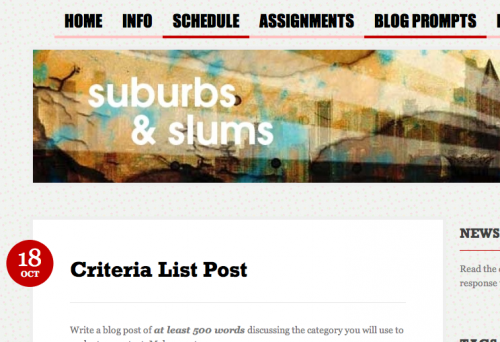
Image Credit:
Lisa Gulessarian
As a student myself in Dr. Lester Faigley’s Visual Rhetoric class four years ago, we used Blackboard’s “Forum” feature to initiate online discussions about our readings while sitting in front of computers in the same classroom. I remember how invigorating it was to respond to my classmates’ posts as they wrote them. I also found that having a written record of my thoughts on the readings served as great review for when I wanted to refer to theories from these readings later in the course. In Dr. Faigley’s course, our class forum was a way for a shy, novice graduate student (i.e. ME!) to contribute to the discussion without feeling overwhelmed.
Now, years later, I’m experimenting with a course blog in my Rhetoric of Suburbs & Slums class. I’m already quite happy with the results.
At first, I envisioned the blog as a place for students to share their research with other students, but after a few days of mulling over using a new pedagogical tool in my class, I quickly realized that the blog could do much more than function as a mini-version of Facebook’s “Share a link” feature. Not only could I get students to share their research with their peers—with a blog, I could get them to work on their writing!
After their initial blog post where they introduced themselves (and became familiar with the idiosyncrasies of Wordpress), I’ve had students write two longer blog posts. The first was a rhetorical analysis paragraph (on one appeal from the source that they’d be analyzing in their first paper). The second was a criteria list based on a category of evaluation of their own choosing (related to the source that they’d be evaluating in their second paper). For both blog posts, I’m impressed at the level of engagement and effort that students put into writing and conceptualizing their posts.
I’m equally impressed by the careful and astute comments their peers left them. After each post was due, I asked students to post comments on the posts above and below their own. They wrote these comments in class as I walked around the room listening to their keys clicking and their videos playing (in their posts, many students included the videos or the images that they were going to analyze/evaluate). For each blog post, I asked students to watch for common setbacks, such as not tying audience to the appeal (for the rhetorical analysis post) or coming up with too-broad criteria (for the criteria list post). In both cases, students were able to alert their peers of potential problems with short comments (I asked for 6 sentences). After reading her peer’s criteria post on a music video, one student wrote “You could make [your criteria] clearer by mentioning which of these criteria are specific to which aspect of the video (images, music, lyrics, etc.) since it is a little confusing if you are evaluating a video or a song or the text of the lyrics.” Another student saw a problem in his peer’s too-general criteria and let his peer know that “The criteria of visual elements is also a little vague. Visual elements can range from camera angles to color use to computer generated elements like change is saturation and use of negative, so being specific on exactly what kind of visual elements you are referring to would be helpful.” And another student brought in prior knowledge to help her peer enlarge the scope of his criteria: “Also another thing you could talk about for visual style of a drama is lighting. In a film class I recently took my professor discussed some of the differences between sitcoms and dramas. He felt that sitcoms consist of generally bright lighting. Is this the same for dramas? Or do you think there is contrast with varied lighting techniques? Just something to possibly think about if you feel that you could add more to the explanation of that criterion.”
Of course, with this blog posts, as with any peer review, my students also gained a deeper knowledge of how they should proceed in their own writing. One student, after reading her peer’s criteria list, wrote: “I also like the way you pull direct examples from the show for your blog post (I probably should have done that for mine….oops!).” Another student told her peer that she used his post as a guide in writing her own criteria list post by writing “I actually used yours to write mine! THANKS!” Because I’m using the Learning Record, my students can document the moments that they gained confidence through the comments they both received and left for others.
An added benefit to all this blogging is that my students end up learning about each other. The camaraderie in my class is one that I would like to recreate in my future classes. Now students know about each other’s interests outside of class. After reading a blog post on a specific category of movies, one student exclaimed: “You seem to be very excited about this particular category and I feel like the information you have written just flowed out of you while blogging!” Another student, who especially appreciated her peer’s detailed justifications of her chosen criteria, happily admitted that “The way you wrote about the criteria that you’ll use to evaluate this source is really interesting. Your detailed writing makes me want to see the video now!”
In general, I’ve loved using blogging in my course. I will continue to ask students to compose mini-writing assignments for the blog. But most importantly, I will definitely make sure that they comment on their peers’ posts.

